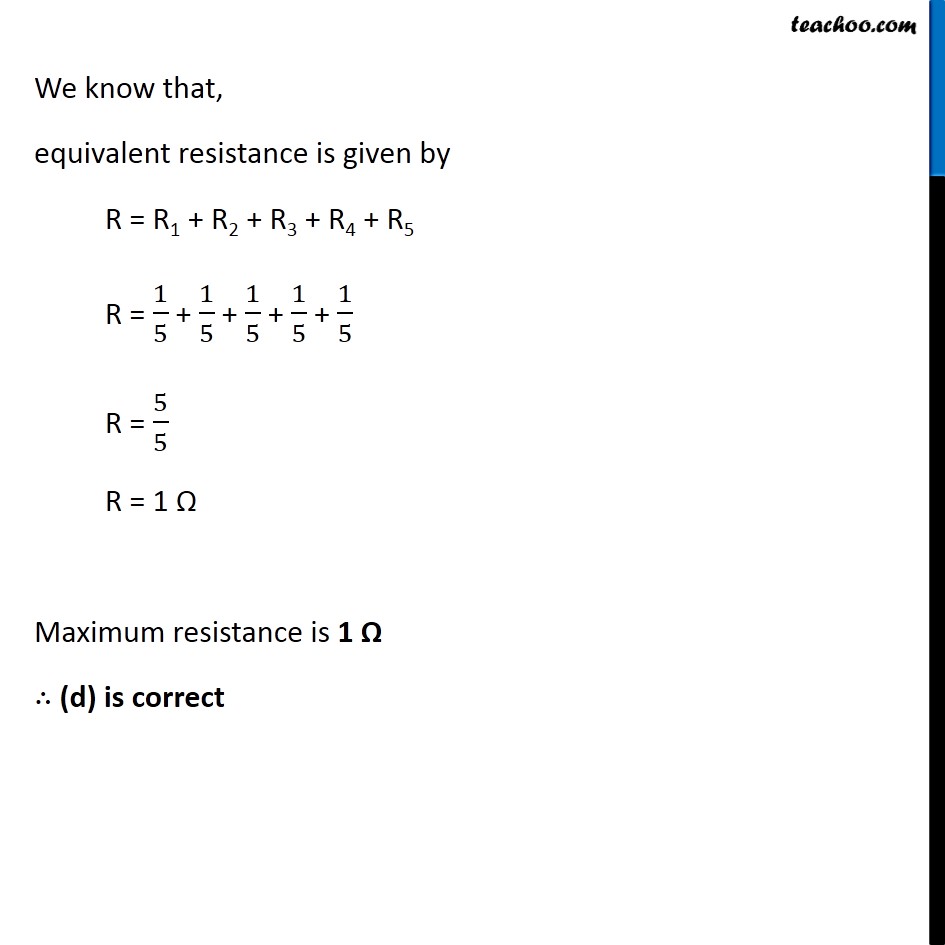Download the questions here
The password to open the file is - teachooisbest
A current of 1 A is drawn by a filament of an electric bulb. Number of electrons passing through a cross section of the filament in 16 seconds would be roughly
(a) 10 20
(b) 10 16
(c) 10 18
(d) 10 23
Answer



What is the maximum resistance which can be made using five resistors each of 1/5 Ω?
(a) 1/5 Ω
(b) 10 Ω
(c) 5 Ω
(d) 1 Ω
Answer


What is the minimum resistance which can be made using five resistors each of 1/5 Ω?
(a) 1/5 Ω
(b) 1/25 Ω
(c) 1/10 Ω
(d) 25 Ω
Answer


A cylindrical conductor of length l and uniform area of cross section A has resistance R. Another conductor of length 2l and resistance R of the same material has area of cross section
(a) A/2
(b) 3A/2
(c) 2A
(d) 3A
Answer



The resistivity does not change if
(a) the material is changed
(b) the temperature is changed
(c) the shape of the resistor is changed
(d) both material and temperature are changed
Answer
the shape of the resistor is changed
Explanation -
The resistivity of a substance depends on the nature of the material and the physical conditions like temperature.
It does not depend on the shape of the resistor.
In an electrical circuit two resistors of 2 Ω and 4 Ω respectively are connected in series to a 6 V battery. The heat dissipated by the 4 Ω resistor in 5 s will be
(a) 5 J
(b) 10 J
(c) 20 J
(d) 30 J
Answer




In an electrical circuit two resistors of 2 Ω and 4 Ω respectively are connected in parallel to a 6 V battery. The heat dissipated by the 4 Ω resistor in 5 s will be
(a) 45 J
(b) 20 J
(c) 60 J
(d) 35 J
Answer




A cell, a resistor, a key and ammeter are arranged as shown in the circuit diagrams below. The current recorded in the ammeter will be

(a) maximum in (i)
(b) maximum in (ii)
(c) maximum in (iii)
(d) the same in all the cases
Answer
(d) the same in all the cases
Explanation -
The current flowing in a circuit does not depend upon the arrangement of the different components, unless they are connected in a different way (Series is changed into parallel, or vice versa.
A child has drawn the electric circuit to study Ohm’s law as shown in Figure 12.6. His teacher told that the circuit diagram needs correction. Study the circuit diagram and redraw it after making all corrections.
Answer


Draw a circuit diagram of an electric circuit containing a cell, a key, an ammeter, a resistor of 2 Ω in series with a combination of two resistors (4 Ω each) in parallel and a voltmeter across the parallel combination. Will the potential difference across the 2 Ω resistor be the same as that across the parallel combination of 4Ω resistors? Give reason.
Answer



Find out the following in the electric circuit given in Figure 12.9
(a) Effective resistance of two 8 W resistors in the combination
(b) Current flowing through 4 W resistor
(c) Potential difference across 4 W resistance
(d) Power dissipated in 4 W resistor
(e) Difference in ammeter readings, if any.
Answer








The figure below shows three cylindrical copper conductors along with their face areas and lengths. Compare the resistance and the resistivity of the three conductors. Justify your answer
Answer

The current flowing through a resistor connected in an electrical circuit and the potential difference developed across its ends are shown in the given ammeter and voltmeter. Find the least count of the voltmeter and ammeter .What is the voltage and the current across the given resistor?
.jpg)
Answer
Finding least count
The smallest value that can be measured by a measuring instrument is called its least count.
Numerically,
Least count = Value measure in N divisions/ N
| Ammeter | Voltmeter |

|

|
|
We can see that, 10 divisions measure 0.2A current
Therefore,
|
We can see that, 10 divisions measure 1 V potential difference
Therefore,
Least count = 1/10
= 0.1 V
Least count of voltmeter is 0.1 V
|
Finding Current through the circuit
The current through the circuit is given by,
Current = Number of division the ammeter needle is pointing x least count
In the given figure, The ammeter needle is pointing on the 15th divison
Hence,
Current = Number of division the ammeter needle is pointing x least count
= 15 × 0.02
= 15 × 2 / 100
= 30 / 100
= 3/10
= 0.3 A
The ammeter reading is 0.3 A.
Finding potential difference in the circuit
The potential difference in the circuit is given by,
Potential difference = Number of division the voltmeter needle is pointing x least count
In the given figure, The voltmeter needle is pointing on the 21st divison
Hence,
Potential difference = Number of division the ammeter needle is pointing x least count
= 21 × 0.1
= 21 × 1/10
= 21/10
= 2.1 V
The voltmeter reading is 2.1V
In a given ammeter, a student sees that needle indicates 17 divisions in ammeter while performing an experiment to verify Ohm’s law. If ammeter has 10 divisions between 0 and 0.5A, then what is the value corresponding to 17 divisions?
Answer
The current through the circuit is given by,
Current = Number of division the ammeter needle is pointing × least count
The smallest value that can be measured by a measuring instrument is called its least count.
Numerically,
Least count = Value measure in N divisions/ N
According to the question,
There are 10 divisions between 0 and 0.5A
Hence, 10 divisions measure 0.5A current
Therefore,
Least count = Value measure in N divisions/ N
Least count = 0.5/10
= 5/ 10 × 10
= 5/ 100
= 0.05 A
Least count of ammeter is 0.05 A
The current through the circuit is given by,
Current = Number of division the ammeter needle is pointing x least count
According to the question, The ammeter needle is pointing on the 17th divison
Hence,
Current = Number of division the ammeter needle is pointing × least count
= 17 × 0.05
= 17 × 5 / 100
= 85 / 100
= 0.85 A
The ammeter reading is 0.85 A.
